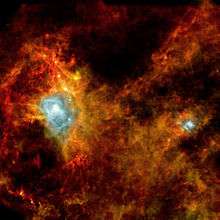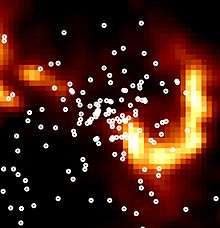Westerhout 40
| W 40 | |
|---|---|
.jpg) Blue: X-ray (Chandra ACIS); Green: 5.8 µm (Spitzer IRAC); Red: 8.0 µm (Spitzer IRAC) | |
| Observation data (J2000 epoch) | |
| Constellation | Serpens Cauda |
| Right ascension | 18 31 29 |
| Declination | -02 05.4 |
| Distance | 1420±30 ly [1] (436±9 pc) |
| Apparent dimensions (V) | 8 arcminutes[2] |
| Physical characteristics | |
| Estimated age | 0.8–1.5 Myr [3] |
| Other designations | W40, Sh2-64, RCW 174, "Aquila" star-forming region [4] |
Westerhout 40 or W40 (also designated Sharpless 64, Sh2-64, or RCW 174) is a star-forming region in the Milky Way Galaxy in the constellation Serpens Cauda. The region has the appearance of a diffuse nebula that contains a cluster of several hundred young stars.[2][5][6] The distance to the region is 436±9 pc (1420±30 light-years),[1] making it one of the nearest sites of formation of high-mass O- and B-type stars.[7] However, it is highly obscured by its molecular cloud, and cannot easily be observed in visible wavelengths of light.[2][8] Ionizing radiation from the massive OB stars has created an H II region[9] which has an hour-glass morphology.[5]
Like all star-forming regions, W40 is made up of several components: the cluster of new-born stars and the gaseous material from which these stars form (the interstellar medium). Most of the gas is in the form of molecular clouds, the coldest, densest phase of the interstellar medium, which is made up of mostly molecular hydrogen (H2). However, feedback from the star cluster has ionized some of the gas and blown a bubble in the cloud around the cluster.
On the Sky
The W40 star-forming region is projected on the sky in the direction of the Serpens-Aquila Rift, a mass of dark clouds above the Galactic plane in the constellations Aquila, Serpens, and eastern Ophiuchus.[10] The high extinction from these foreground clouds means that this region looks unimpressive in the optical, despite being one of the nearest sites of massive star formation. Also residing nearby on the sky are Serpens south, an infrared dark cloud that is actively forming stars,[11] and the Serpens Main cluster.

Star cluster
A cluster of young stars lies at the center of the W40 HII region containing approximately 520 stars[2][12] down to 0.1 solar masses (M☉). Age estimates for the stars indicate that the stars in the center of the cluster are approximately 0.8 million years old, while the stars on the outside are slightly older at 1.5 million years.[3] The cluster is roughly spherically symmetric and is mass segregated, with the more massive stars relatively more likely to be found near the center of the cluster.[2] The cause of mass segregation in very young star clusters, like W40, is an open theoretical question in star-formation theory because timescales for mass segregation through two-body interactions between stars are typically too long.[13][14]
The cloud is ionized by several O and B-type stars.[15] Near-infrared spectroscopy has identified one late-O type star named IRS 1A South, and 3 early B-type stars, IRS 2B, IRS 3A, and IRS 5. In addition, IRS 1A North and IRS 2A are Herbig Ae/Be stars.[7] Radio emission from several of these stars is observed with the Very Large Array, and may be evidence for ultra-compact H II regions.[16]
Excess light in the infrared indicates that a number of stars in the cluster have circumstellar disks, which may be in the process of forming planets.[2] Millimeter observations from the IRAM 30m telescope show 9 Class-0 protostars in the Serpens South region and 3 Class-0 protostars in W40,[17] supporting the view that the region is very young and actively forming stars.
Interstellar medium
W40 lies in a molecular cloud with an estimated mass of 104 M☉.[5] The core of the molecular cloud has a shape like a shepard's crook and is currently producing new stars.[17][18] The cluster of OB and pre–main-sequence (PMS) stars lies just eastward of the bend in this filament. The cloud core was also observed in radio light produced by CO, which allows the mass of the core to be estimated at 200–300 M☉. A weak, bipolar outflow of gas flows out of the core, likely driven by a young stellar object, with two lobes differing in velocity by 0.5 km/s.[19]
It was in this region where the striking prevalence of filamentary cloud structures seen by ESA's Herschel Space Observatory was first noted.[4] These filaments of cloud have dense "cores" of gas embedded within them—many of which are likely to gravitationally collapse and form stars. The Herschel results for this region, and subsequently reported results for other star-forming regions, imply that fragmentation of molecular-cloud filaments are fundamental to the star-formation process. The Herschel results for W40 and the Aquila Rift, compared to those for molecular clouds in the Polaris region, suggest that star-formation occurs when the linear density (mass per unit length) exceeds a threshold making them susceptible to gravitational instability. This accounts for the high star-formation rate in W40 and the Aquila Rift, in contrast to the low star-formation rate in the Polaris clouds. These observational results complement computer simulations of star-formation, which also emphasize the role that molecular-cloud filaments play in the birth of stars.[22]
Observations by the space-based Chandra X-ray Observatory have shown a diffuse X-ray glow from the H II region, which is likely due to the presence of a multi-million Kelvin plasma.[2][23] Such hot plasmas can be produced by winds from massive stars, which become shock heated.
Gallery
 Spitzer Space Telescope mosaic image of W40.[24]
Spitzer Space Telescope mosaic image of W40.[24]_in_the_W40_region.jpg) A close-up of an IRDC in the Spitzer image.
A close-up of an IRDC in the Spitzer image. The W40 cluster in the X-ray.[2]
The W40 cluster in the X-ray.[2] W40 and its environs seen by Herschel.[4]
W40 and its environs seen by Herschel.[4]
_from_Mount_Lemmon_SkyCenter.jpg) An optical image of W40 from Mount Lemmon SkyCenter.[25]
An optical image of W40 from Mount Lemmon SkyCenter.[25]
See also
- H II Region
- Star Formation
- Sharpless Catalog
- RCW Catalog
- Serpens South
- List of Star-Forming Regions in the Local Group
Coordinates: ![]() 18h 31m 29s, −02° 05′ 36″
18h 31m 29s, −02° 05′ 36″
References
- 1 2 Ortiz-León, G. N.; et al. (2016). "The Gould's Belt Distances Survey (GOBELINS) III. The distance to the Serpens/Aquila Molecular Complex". Astrophysical Journal. arXiv:1610.03128
 . Bibcode:2016arXiv161003128O.
. Bibcode:2016arXiv161003128O. - 1 2 3 4 5 6 7 8 Kuhn, M. A.; et al. (2010). "A Chandra Observation of the Obscured Star-forming Complex W40". Astrophysical Journal. 725 (2): 2485–2506. arXiv:1010.5434
 . Bibcode:2010ApJ...725.2485K. doi:10.1088/0004-637X/725/2/2485.
. Bibcode:2010ApJ...725.2485K. doi:10.1088/0004-637X/725/2/2485. - 1 2 Getman, K. V.; et al. (2014). "Age Gradients in the Stellar Populations of Massive Star Forming Regions Based on a New Stellar Chronometer". Astrophysical Journal. 787 (2): 108. arXiv:1403.2741
 . Bibcode:2014ApJ...787..108G. doi:10.1088/0004-637X/787/2/108.
. Bibcode:2014ApJ...787..108G. doi:10.1088/0004-637X/787/2/108. - 1 2 3 André, Ph.; et al. (2010). "From filamentary clouds to prestellar cores to the stellar IMF: Initial highlights from the Herschel Gould Belt Survey". Astronomy & Astrophysics. 518: 102. arXiv:1005.2618
 . Bibcode:2010A&A...518L.102A. doi:10.1051/0004-6361/201014666.
. Bibcode:2010A&A...518L.102A. doi:10.1051/0004-6361/201014666. - 1 2 3 Rodney, S. A.; Reipurth, B. (2008). "The W40 Cloud Complex". In Reipurth, B. Handbook of Star Forming Regions, Volume II: The Southern Sky ASP Monograph Publications. 5. p. 43. ISBN 978-1-58381-670-7.
- ↑ Mallick, K. K.; et al. (2013). "The W40 Region in the Gould Belt: An Embedded Cluster and H II Region at the Junction of Filaments". Astrophysical Journal. 779 (2): 113. arXiv:1309.7127
 . Bibcode:2013ApJ...779..113M. doi:10.1088/0004-637X/779/2/113.
. Bibcode:2013ApJ...779..113M. doi:10.1088/0004-637X/779/2/113. - 1 2 Shuping, R. Y.; et al. (2012). "Spectral Classification of the Brightest Objects in the Galactic Star-forming Region W40". Astronomical Journal. 144 (4): 116. arXiv:1208.4648
 . Bibcode:2012AJ....144..116S. doi:10.1088/0004-6256/144/4/116.
. Bibcode:2012AJ....144..116S. doi:10.1088/0004-6256/144/4/116. - 1 2 Hagenauer, Beth; Veronico, Nicholas (Nov 21, 2011). "NASA'S SOFIA Airborne Observatory Views Star Forming Region W40" (Press release). Moffett Field, CA. NASA. Retrieved Mar 8, 2015.
- ↑ Vallee, J. P. (1987). "The warm C II region between the hot ionized region S 64 = W 40 and the cold molecular cloud G 28.74 + 3.52". Astronomy & Astrophysics. 178: 237. Bibcode:1987A&A...178..237V.
- ↑ Straižys, V.; et al. (1996). "Interstellar extinction in the area of the Serpens Cauda molecular cloud". Baltic Astronomy. 5 (1): 125–147. Bibcode:1996BaltA...5..125S.
- ↑ Gutermuth, R. A.; et al. (2008). "The Spitzer Gould Belt Survey of Large Nearby Interstellar Clouds: Discovery of a Dense Embedded Cluster in the Serpens-Aquila Rift". Astrophysical Journal. 673 (2): L151–L154. arXiv:0712.3303
 . Bibcode:2008ApJ...673L.151G. doi:10.1086/528710.
. Bibcode:2008ApJ...673L.151G. doi:10.1086/528710. - ↑ Kuhn, M. A.; Getman, K. V.; Feigelson, E. D. (2015). "The Spatial Structure of Young Stellar Clusters. II. Total Young Stellar Populations". Astrophysical Journal. 802: 60. arXiv:1501.05300
 . Bibcode:2015ApJ...802...60K. doi:10.1088/0004-637X/802/1/60.
. Bibcode:2015ApJ...802...60K. doi:10.1088/0004-637X/802/1/60. - ↑ Küpper, A. H. W.; et al. (2011). "Mass segregation and fractal substructure in young massive clusters - I. The McLuster code and method calibration". Monthly Notices of the Royal Astronomical Society. 417 (3): 2300–2317. arXiv:1107.2395
 . Bibcode:2011MNRAS.417.2300K. doi:10.1111/j.1365-2966.2011.19412.x.
. Bibcode:2011MNRAS.417.2300K. doi:10.1111/j.1365-2966.2011.19412.x. - ↑ Krumholz, M. R. (2014). "The Big Problems in Star Formation: the Star Formation Rate, Stellar Clustering, and the Initial Mass Function". Physics Reports. 539: 49–134. arXiv:1402.0867
 . Bibcode:2014PhR...539...49K. doi:10.1016/j.physrep.2014.02.001.
. Bibcode:2014PhR...539...49K. doi:10.1016/j.physrep.2014.02.001. - ↑ Smith, J.; et al. (1985). "Infrared sources and excitation of the W40 complex". Astrophysical Journal. 291: 571–580. Bibcode:1985ApJ...291..571S. doi:10.1086/163097.
- ↑ Rodríguez, L. F.; et al. (2011). "A Cluster of Compact Radio Sources in W40". Astronomical Journal. 140 (4): 968–972. arXiv:1007.4974
 . Bibcode:2010AJ....140..968R. doi:10.1088/0004-6256/140/4/968.
. Bibcode:2010AJ....140..968R. doi:10.1088/0004-6256/140/4/968. - 1 2 Maury, A. J.; et al. (2011). "The formation of active protoclusters in the Aquila rift: a millimeter continuum view". Astronomy & Astrophysics. 535: 77. arXiv:1108.0668
 . Bibcode:2011A&A...535A..77M. doi:10.1051/0004-6361/201117132.
. Bibcode:2011A&A...535A..77M. doi:10.1051/0004-6361/201117132. - ↑ Pirogov, L. (2013). "Molecular line and continuum study of the W40 cloud". Monthly Notices of the Royal Astronomical Society. 436 (4): 3186–3199. arXiv:1309.6188
 . Bibcode:2013MNRAS.436.3186P. doi:10.1093/mnras/stt1802.
. Bibcode:2013MNRAS.436.3186P. doi:10.1093/mnras/stt1802. - ↑ Zhu, L.; et al. (2006). "A Study of the Molecular Cloud S64 with Multiple Lines of CO Isotopes". Chinese Journal of Astronomy and Astrophysics. 6 (1): 61–68. Bibcode:2006ChJAA...6...61Z. doi:10.1088/1009-9271/6/1/007.
- ↑ Feigelson, E. D.; et al. (2013). "Overview of the Massive Young Star-Forming Complex Study in Infrared and X-Ray (MYStIX) Project". Astrophysical Journal Supplement. 209 (2): 26. arXiv:1309.4483
 . Bibcode:2013ApJS..209...26F. doi:10.1088/0067-0049/209/2/26.
. Bibcode:2013ApJS..209...26F. doi:10.1088/0067-0049/209/2/26. - ↑ Broos, P. S.; et al. (2013). "Identifying Young Stars in Massive Star-forming Regions for the MYStIX Project". Astrophysical Journal Supplement. 209 (2): 32. arXiv:1309.4500
 . Bibcode:2013ApJS..209...32B. doi:10.1088/0067-0049/209/2/32.
. Bibcode:2013ApJS..209...32B. doi:10.1088/0067-0049/209/2/32. - ↑ Bate, M. R.; et al. (2003). "The formation of a star cluster: predicting the properties of stars and brown dwarfs". Monthly Notices of the Royal Astronomical Society. 339 (3): 577–599. arXiv:astro-ph/0212380
 . Bibcode:2003MNRAS.339..577B. doi:10.1046/j.1365-8711.2003.06210.x.
. Bibcode:2003MNRAS.339..577B. doi:10.1046/j.1365-8711.2003.06210.x. - ↑ Townsley, L. K.; et al. (2014). "The Massive Star-Forming Regions Omnibus X-Ray Catalog". Astrophysical Journal Supplement. 213 (1): 1. arXiv:1403.2576
 . Bibcode:2014ApJS..213....1T. doi:10.1088/0067-0049/213/1/1.
. Bibcode:2014ApJS..213....1T. doi:10.1088/0067-0049/213/1/1. - ↑ Povich, M. S.; et al. (2013). "The MYStIX Infrared-Excess Source Catalog". Astrophysical Journal Supplement. 209 (2): 31. arXiv:1309.4497
 . Bibcode:2013ApJS..209...31P. doi:10.1088/0067-0049/209/2/31.
. Bibcode:2013ApJS..209...31P. doi:10.1088/0067-0049/209/2/31. - ↑ Block, A. (2013). "SH2-64". http://www.caelumobservatory.com. Retrieved September 26, 2015. External link in
|website=(help)
